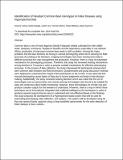| dc.description.abstract | Common bean is one of many legumes (family Fabaceae) widely cultivated for their edible seeds, seedpods, and leaves. Despite its benefits and life dependency especially in sub-Saharan Africa, production of improved common bean seeds is still a problem. Among the major problems that the bean breeders are facing is manual phenotyping which led to slowing the field processes.According to the literature, imaging technologies have been introduced to help in different processes for crop management and production. However, there is a lack of automated mechanisms for phenotyping processes. Therefore, this study has reviewed existing mechanisms among breeders in Tanzania in order to propose suitable mechanisms for effective phenotyping processes. In the process of data collection, the study interviewed 60 participants among which were common bean breeders and field technicians. Questionnaires and group discussion methods were deployed to understand the insight of the participants on the current. It was observed that manual phenotyping causes biases of data due to human judgments and leads to late decision-making. Additionally, the study reviewed existing literature and it was noted that the use of technologies such as spectrometry and remote sensing technologies were found to be suitable for early and continuous plant health monitoring. However, these technologies are of high cost and produce complex outputs for the breeders to understand. However, there is a way in which these techniques can be innovatively integrated with artificial intelligence (AI) techniques in order to produce required outputs that are easy to understand and cost-effective.Based on the findings, this study proposes the development of a Hyperspectral-based system that will be used for automating phenotyping, data collection, and analysis. The system will be developed using AI that uses spectral bands captured using a cheap handheld spectrometer for the early detection of foliar diseases in bean varietie... | en_US |

